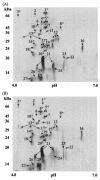Effect of acidic pH on expression of surface-associated proteins of Streptococcus oralis
- PMID: 12957916
- PMCID: PMC194962
- DOI: 10.1128/AEM.69.9.5290-5296.2003
Effect of acidic pH on expression of surface-associated proteins of Streptococcus oralis
Abstract
Streptococcus oralis, a member of the mitis group of oral streptococci, is implicated in the pathogenesis of infective endocarditis and is the predominant aciduric non-mutans-group streptococcus in dental plaque. We undertook to identify the most abundant surface-associated proteins of S. oralis and to investigate changes in protein expression when the organism was grown under acidic culture conditions. Surface-associated proteins were extracted from cells grown in batch culture, separated by two-dimensional gel electrophoresis, excised, digested with trypsin, and analyzed by matrix-assisted laser desorption ionization-time of flight mass spectrometry and liquid chromatography-tandem mass spectrometry. Putative functions were assigned by homology to a translated genomic database of Streptococcus pneumoniae. A total of 27 proteins were identified; these included a lipoprotein, a ribosome recycling factor, and the glycolytic enzymes phosphoglycerate kinase, fructose bisphosphate aldolase, glyceraldehyde-3-phosphate dehydrogenase, and enolase. The most abundant protein, phosphocarrier protein HPr, was present as three isoforms. Neither lactate dehydrogenase nor pyruvate oxidase, dominant intracellular proteins, were present among the proteins on the gels, demonstrating that proteins in the surface-associated pool did not arise as a result of cell lysis. Eleven of the proteins identified were differentially expressed when cells were grown at pH 5.2 versus pH 7.0, and these included superoxide dismutase, a homologue of dipeptidase V from Lactococcus lactis, and the protein translation elongation factors G, Tu, and Ts. This study has extended the range of streptococcal proteins known to be expressed at the cell surface. Further investigations are required to ascertain their functions at this extracellular location and determine how their expression is influenced by other environmental conditions.
Figures


Similar articles
-
Altered protein expression of Streptococcus oralis cultured at low pH revealed by two-dimensional gel electrophoresis.Appl Environ Microbiol. 2001 Aug;67(8):3396-405. doi: 10.1128/AEM.67.8.3396-3405.2001. Appl Environ Microbiol. 2001. PMID: 11472910 Free PMC article.
-
Analysis of Streptococcus mutans proteins modulated by culture under acidic conditions.Appl Environ Microbiol. 2002 May;68(5):2382-90. doi: 10.1128/AEM.68.5.2382-2390.2002. Appl Environ Microbiol. 2002. PMID: 11976112 Free PMC article.
-
Use of MALDI Biotyper plus ClinProTools mass spectra analysis for correct identification of Streptococcus pneumoniae and Streptococcus mitis/oralis.J Clin Pathol. 2015 Aug;68(8):652-6. doi: 10.1136/jclinpath-2014-202818. Epub 2015 May 13. J Clin Pathol. 2015. PMID: 25972224
-
Lipid requirement of membrane-bound enzymes.J Bioenerg Biomembr. 1977 Dec;9(6):373-86. doi: 10.1007/BF00743152. J Bioenerg Biomembr. 1977. PMID: 18265747 Review. No abstract available.
-
Novel insights into filament-forming enzymes.Nat Rev Mol Cell Biol. 2020 Jan;21(1):1-2. doi: 10.1038/s41580-019-0188-1. Epub 2019 Nov 1. Nat Rev Mol Cell Biol. 2020. PMID: 31676888 Review. No abstract available.
Cited by
-
Expression of an Extracellular Protein (SMU.63) Is Regulated by SprV in Streptococcus mutans.Appl Environ Microbiol. 2020 Nov 24;86(24):e01647-20. doi: 10.1128/AEM.01647-20. Print 2020 Nov 24. Appl Environ Microbiol. 2020. PMID: 32978138 Free PMC article.
-
Functional analysis of glucan binding protein B from Streptococcus mutans.J Bacteriol. 2006 Jun;188(11):3813-25. doi: 10.1128/JB.01845-05. J Bacteriol. 2006. PMID: 16707674 Free PMC article.
-
A multiomics analysis of direct interkingdom dynamics between influenza A virus and Streptococcus pneumoniae uncovers host-independent changes to bacterial virulence fitness.PLoS Pathog. 2022 Dec 21;18(12):e1011020. doi: 10.1371/journal.ppat.1011020. eCollection 2022 Dec. PLoS Pathog. 2022. PMID: 36542660 Free PMC article.
-
Streptococcus adherence and colonization.Microbiol Mol Biol Rev. 2009 Sep;73(3):407-50, Table of Contents. doi: 10.1128/MMBR.00014-09. Microbiol Mol Biol Rev. 2009. PMID: 19721085 Free PMC article. Review.
-
A signal-arrest-release sequence mediates export and control of the phage P1 endolysin.Proc Natl Acad Sci U S A. 2004 Apr 27;101(17):6415-20. doi: 10.1073/pnas.0400957101. Epub 2004 Apr 16. Proc Natl Acad Sci U S A. 2004. PMID: 15090650 Free PMC article.
References
-
- Beighton, D., A. D. Carr, and B. A. Oppenheim. 1994. Identification of viridans streptococci associated with bacteraemia in neutropenic cancer patients. J. Med. Microbiol. 40:202-204. - PubMed
-
- Bentley, R. W., J. A. Leigh, and M. D. Collins. 1991. Intrageneric structure of Streptococcus based on comparative analysis of small-subunit rRNA sequences. Int. J. Syst. Bacteriol. 41:487-494. - PubMed
-
- Bergmann, S., M. Rohde, G. S. Chhatwal, and S. Hammerschmidt. 2001. α-Enolase of Streptococcus pneumoniae is a plasmin(ogen)-binding protein displayed on the bacterial cell surface. Mol. Microbiol. 40:1273-1287. - PubMed
-
- Brailsford, S. R., R. W. Byrne, S. Adams, L. Zoitopoulos, C. Allison, and D. Beighton. 1999. Investigation of the aciduric microflora of plaque. Caries Res. 33:290.
Publication types
MeSH terms
Substances
LinkOut - more resources
Full Text Sources
Research Materials

